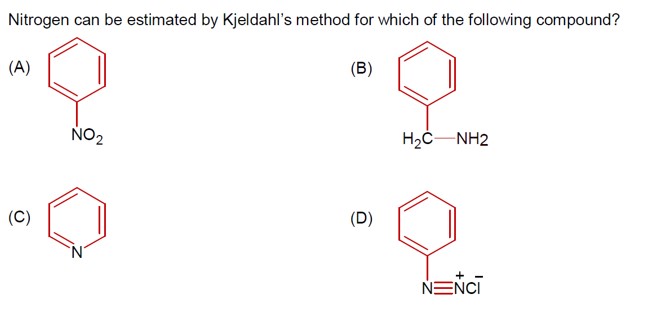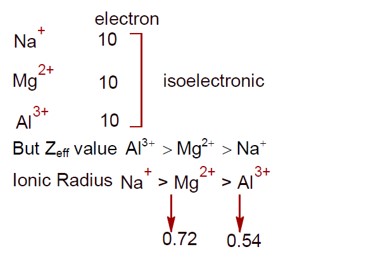Class 11th
Get insights from 8k questions on Class 11th, answered by students, alumni, and experts. You may also ask and answer any question you like about Class 11th
Follow Ask QuestionQuestions
Discussions
Active Users
Followers
New question posted
2 months agoNew answer posted
2 months agoContributor-Level 10
The Kjeldahl method is not applicable for nitrogen estimation in:
Compounds containing nitrogen in a nitro group.
Compounds containing an Azo group.
Pyridine.
New answer posted
2 months agoContributor-Level 10
Initial mean of 25 observations is 40.
X? = (Σx? )/25 = 40 => Σx? = 25 * 40 = 1000.
A teacher of age 60 retires.
The new sum of ages for the remaining 24 people is 1000 - 60 = 940.
A new teacher of age x joins.
The new sum for 25 people is 940 + x.
The new mean is 39.
(940 + x) / 25 = 39
940 + x = 39 * 25 = 975
x = 975 - 940 = 35.
The new teacher's age is 35.
New answer posted
2 months agoContributor-Level 10
Sucralose: Artificial sweetener
Glyceryl ester of stearic acid: The document incorrectly identifies this as "Sodium stearate which is synthetic detergent". Sodium stearate is a soap, not a synthetic detergent.
Sodium benzoate: Food preservative
Bithionol: Antiseptic
New answer posted
2 months agoContributor-Level 10
f (x) = ∫ (5x? + 7x? ) / (x² + 1 + 2x? ) dx seems to have a typo in the denominator. Based on the solution, the denominator is (x? + 1/x? + 2)² or similar. Let's follow the solution's steps.
It seems the denominator is (x? (2 + 1/x? + 1/x? )² = x¹? (2 + 1/x? + 1/x? )².
f (x) = ∫ (5x? + 7x? ) / (x¹? (2 + 1/x? + 1/x? )²) dx
The solution simplifies the integrand to:
f (x) = ∫ (5/x? + 7/x? ) / (2 + 1/x? + 1/x? )² dx
Let t = 2 + 1/x? + 1/x?
dt = (-5/x? - 7/x? ) dx = - (5/x? + 7/x? ) dx.
The integral becomes:
f (x) = ∫ -dt / t² = 1/t + C.
f (x) = 1 / (2 + 1/x? + 1/x? ) + C.
Given f (0)=0, this form has a division by zero. Let's re-ex
New answer posted
2 months agoContributor-Level 10
Given the equation y = 3 + 1/ (4 + 1/y).
y - 3 = 1 / (4y+1)/y)
y - 3 = y / (4y+1)
(y-3) (4y+1) = y
4y² + y - 12y - 3 = y
4y² - 11y - 3 = y
4y² - 12y - 3 = 0
Using the quadratic formula to solve for y:
y = [-b ± √ (b²-4ac)] / 2a
y = [12 ± √ (-12)² - 4*4* (-3)] / (2*4)
y = [12 ± √ (144 + 48)] / 8
y = [12 ± √192] / 8 = [12 ± 8√3] / 8 = 3/2 ± √3.
y = 1.5 ± √3.
Since y > 0 (from the structure of the equation), both solutions are positive. The solution selects y = 1.5 + √3.
New answer posted
2 months agoContributor-Level 10
Evaluate the limit:
L = lim (x→0) [sin? ¹ (x) - tan? ¹ (x)] / 3x³
Using Taylor series expansions around x=0:
sin? ¹ (x) = x + x³/6 + O (x? )
tan? ¹ (x) = x - x³/3 + O (x? )
L = lim (x→0) [ (x + x³/6) - (x - x³/3) ] / 3x³
L = lim (x→0) [ x³/6 + x³/3 ] / 3x³
L = lim (x→0) [ (1/6 + 1/3)x³ ] / 3x³
L = (1/2) / 3 = 1/6
The solution shows 3L = 1/2, which is correct. And 6L = 1, also correct.
The final line 6L+1=2 implies 6L=1, confirming the result.
New answer posted
2 months agoContributor-Level 10
Given the determinant:
| α β γ |
| β γ α | = 0
| γ α β |
The expansion of this determinant is - (α³ + β³ + γ³ - 3αβγ) = 0.
This implies (α+β+γ) (α²+β²+γ²-αβ-βγ-γα) = 0.
From a cubic equation x³ + ax² + bx + c = 0 with roots α, β, γ:
α+β+γ = -a
αβ+βγ+γα = b
αβγ = -c
Substituting into the determinant condition:
(-a) ( (α+β+γ)² - 3 (αβ+βγ+γα) ) = 0
(-a) ( (-a)² - 3b ) = 0
-a (a² - 3b) = 0
a (a² - 3b) = 0
This implies a=0 or a²=3b. If a≠0, then a²=3b, so a²/b = 3.
New answer posted
2 months agoContributor-Level 10
Given the family of parabolas y² = 4a (x+a).
Differentiate with respect to x:
2y (dy/dx) = 4a
a = (y/2) (dy/dx)
Substitute a back into the original equation:
y² = 4 * (y/2) (dy/dx) * [x + (y/2) (dy/dx)]
y² = 2y (dy/dx) * [x + (y/2) (dy/dx)]
y = 2 (dy/dx) * [x + (y/2) (dy/dx)]
y = 2x (dy/dx) + y (dy/dx)²
y (dy/dx)² + 2x (dy/dx) - y = 0
Taking an Exam? Selecting a College?
Get authentic answers from experts, students and alumni that you won't find anywhere else
Sign Up on ShikshaOn Shiksha, get access to
- 65k Colleges
- 1.2k Exams
- 679k Reviews
- 1800k Answers



